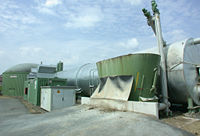
Photo from wikipedia
Abstract This work demonstrates a computational approach for the exploration of the importance of biochemical mechanism parameters in anaerobic digestion models subjected to concentration variations of digestion feedstock components. The… Click to show full abstract
Abstract This work demonstrates a computational approach for the exploration of the importance of biochemical mechanism parameters in anaerobic digestion models subjected to concentration variations of digestion feedstock components. The methodology consists of an algorithm integrating global sensitivity analysis (GSA), functional principal component analysis (FPCA), and rank-clustering techniques. The GSA-FPCA integration removes the time-varying character of GSA (Morris’) indices while the rank-clustering step provides a statistical approach to grouping the ranks of parameter sensitivities as affected by feedstock component variations. To substantiate generalizations of findings, two digestion models of differing complexity were used: Case 1 – single-component feedstock digestion model with substrate inhibition, and Case 2 – rigorous model Anaerobic Digestion Model No. 1 (ADM1). Results indicate that 95–99% of the variations in the time-dependent outputs can be captured by the principal components (PCs) after FPCA transformation, and that the first PC is sufficient to represent the model outputs. This capability of the FPCA to capture overall response curve patterns reduces the dimensionality of model response perturbation measures and makes the resulting data projections onto time-independent sensitivity indices intuitive of response curve perturbations. Ranked Morris sensitivity indices calculated from the first PC scores revealed stoichiometric parameters that dominantly affect kinetic responses as well as least sensitive parameters. The GSA-FPCA-Clustering approach elucidates digestion kinetic patterns only obvious under a systematic GSA methodology.
Journal Title: Biochemical Engineering Journal
Year Published: 2019
Link to full text (if available)
Share on Social Media: Sign Up to like & get
recommendations!